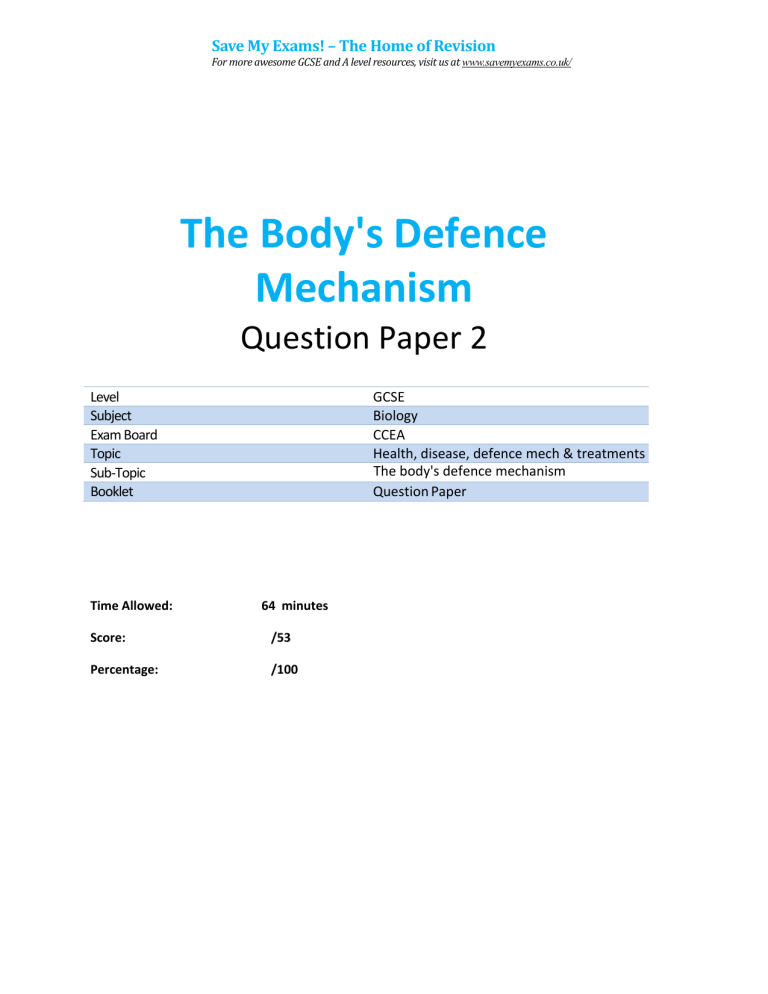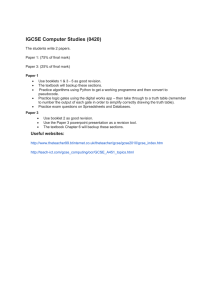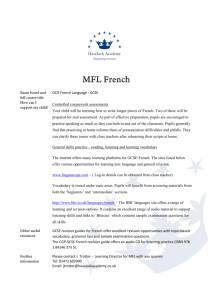
Save My Exams! – The Home of Revision For more awesome GCSE and A level resources, visit us at www.savemyexams.co.uk/ The Body's Defence Mechanism Question Paper 2 GCSE Biology CCEA Health, disease, defence mech & treatments The body's defence mechanism Question Paper Level Subject Exam Board Topic Sub-Topic Booklet Time Allowed: 64 minutes Score: /53 Percentage: /100 Save My Exams! – The Home of Revision For more awesome GCSE and A level resources, visit us at www.savemyexams.co.uk/ Higher Tier 1 Save My Exams! – The Home of Revision For more awesome GCSE and A level resources, visit us at www.savemyexams.co.uk/ 1 The diagram shows a lymphocyte cell producing antibodies in response to bacteria entering the blood. lymphocyte protein A bacterium different types of antibody in the blood antibodies produced by lymphocyte © Chief Examiner (a) Name protein A. _________________________ [1] 2 Save My Exams! – The Home of Revision For more awesome GCSE and A level resources, visit us at www.savemyexams.co.uk/ (b) Lymphocytes bring about immunity by producing antibodies. Name this type of immunity. _________________________ [1] (c) Suggest why there are different types of antibodies already present in the blood. _______________________________________________________________ _____________________________________________________________ [1] (d) Use the diagram to help describe and explain the action of the antibodies on the bacteria. _______________________________________________________________ _______________________________________________________________ _______________________________________________________________ _______________________________________________________________ _____________________________________________________________ [3] After the action of the antibodies, another type of white blood cell destroys the bacteria. (e) Name this type of white blood cell and describe how it destroys the bacteria. _______________________________________________________________ _______________________________________________________________ _______________________________________________________________ _____________________________________________________________ [3] (f) Give two ways the body can prevent bacteria entering the blood. 1. _____________________________________________________________ 2. ___________________________________________________________ [2] 3 Save My Exams! – The Home of Revision For more awesome GCSE and A level resources, visit us at www.savemyexams.co.uk/ 2 (a) The diagram shows antibodies attacking bacteria. bacterium antibody A © Dorling Kindersley / Thinkstock (i) Name structure A on the bacterium. [1] (ii) Describe how antibodies prevent the spread of the bacteria within the body. [2] 4 Save My Exams! – The Home of Revision For more awesome GCSE and A level resources, visit us at www.savemyexams.co.uk/ (b) The graph shows the concentration of antibodies in the blood after vaccination. Two injections were given. Each injection contained the same type of weakened bacteria. SULPDU\UHVSRQVH VHFRQGDU\UHVSRQVH &RQFHQWUDWLRQRIDQWLERGLHVLQ EORRGDUELWUDU\XQLWV ­ ° ° ® ° ° ¯ ­ ® ¯ OHYHORIDQWLERG\ UHTXLUHGWR SURGXFHLPPXQLW\ ILUVW LQMHFWLRQ ERRVWHU LQMHFWLRQ 7LPHPRQWKV (i) Explain why the secondary response is faster than the primary response. [1] (ii) Describe two other differences between the primary and secondary response. [2] 5 Save My Exams! – The Home of Revision For more awesome GCSE and A level resources, visit us at www.savemyexams.co.uk/ (iii) Use evidence from the graph to suggest why a booster injection must be given a few months after the first injection. [2] (iv) Suggest one disadvantage of the vaccination being given as two injections rather than one. [1] (v) Explain why manufacturers of this vaccine weaken the bacteria used in the injections. [2] (vi) Name the type of immunity given by this vaccination. [1] 6 Save My Exams! – The Home of Revision For more awesome GCSE and A level resources, visit us at www.savemyexams.co.uk/ 3 Scientific method involves the following steps: observation, making a hypothesis, experimentation, conclusion, validation. Jenner is famous for having applied scientific method while developing vaccination as a way of preventing smallpox. Some of the steps in Jenner’s development of a smallpox vaccine were: A Infect a person with cowpox. Then infect the person with smallpox. B Jenner and other scientists repeated the procedure and got the same results. C A person infected with cowpox may be protected from smallpox. D Jenner heard dairymaids say “I shall never have smallpox for I have had cowpox”. (a) Which of the steps used by Jenner is an example of observation? [1] validation? [1] (b) Use the information given above to help explain why Jenner’s vaccination is an example of artificial, active immunity. Artificial [1] Active [1] We now know that white blood cells, known as phagocytes, are important in protecting the body against diseases. (c) Describe how phagocytes help protect against diseases. [2] 7 Save My Exams! – The Home of Revision For more awesome GCSE and A level resources, visit us at www.savemyexams.co.uk/ 4 (a) One type of food poisoning is caused by Salmonella microorganisms. Raw chicken often contains Salmonella. If frozen chicken is cooked without being completely defrosted it can cause food poisoning when eaten. To prevent food poisoning frozen chicken should be thoroughly defrosted before cooking. The raw chicken should not be allowed to touch another food which is not going to be cooked. After cooking in a hot oven the chicken should be cooled quickly and stored in a refrigerator at 4 °C. 1 3 5 7 9 (i) Name the type of microorganism which causes Salmonella food poisoning. [1] (ii) Explain how freezing safely preserves chicken. [1] (iii) Suggest why cooking a frozen chicken, which has not been completely defrosted, could result in food poisoning (Line 3). [2] (iv) Explain why cooled, cooked chicken can safely be stored in a fridge at 4 °C for a short period of time (Line 8). [1] (v) Suggest two other precautions which should be taken to prevent the spread of food poisoning. [2] 8 Save My Exams! – The Home of Revision For more awesome GCSE and A level resources, visit us at www.savemyexams.co.uk/ (b) The diagrams show how a vaccine brings about immunity. The diagrams are not all drawn to the same scale. Stage 1 Stage 2 structure Stage 3 microorganism X vaccine injected © Comstock / Thinkstock white blood cell chemicals produced Y structure Z Stage 6 Stage 5 Stage 4 (i) Suggest why microorganisms contained in the vaccine at Stage 1 must be dead or weakened. [1] (ii) Name structure X on the microorganism. [1] (iii) Describe what is happening at Stage 2. [1] 9 Save My Exams! – The Home of Revision For more awesome GCSE and A level resources, visit us at www.savemyexams.co.uk/ (iv) What type of white blood cell is Y? [1] (v) Name structure Z. [1] (vi) Name the chemicals produced by the white blood cell at Stage 3 and describe their effect on the microorganisms at Stage 4. Chemicals [1] Effect [2] (vii)Describe what is happening at Stages 5 and 6. Stage 5 [1] Stage 6 [1] Microorganisms which enter the blood can also be killed by chemicals such as penicillin. (viii) What type of chemical is penicillin? [1] 10 Save My Exams! – The Home of Revision For more awesome GCSE and A level resources, visit us at www.savemyexams.co.uk/ 5 reast il contains all t e nutrients a a y needs in t e correct proportions a a et e d r p needed to pro ide ener y for rowt reast il also contains anti odies plain t e ad anta e of t ese to t e a y c d u est w plain w y er ad anta es of reast feedin positi e ot ers are ad ised not to reast feed 11



